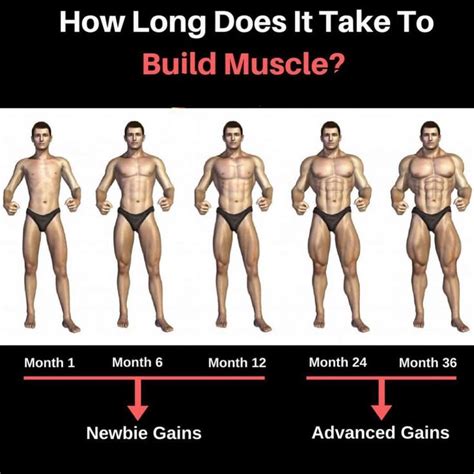How Long Does It Take To Build Muscle? A Realistic Timeline
Building muscle is a journey, not a sprint. While you might see some initial changes quickly, significant muscle growth takes time, dedication, and a well-structured approach. There's no magic number, as the timeline varies greatly depending on several factors. This post will explore those factors and provide a realistic timeframe for seeing noticeable results.
Factors Affecting Muscle Growth
Several key elements influence how quickly you build muscle:
1. Genetics: The Foundation of Your Physique
Your genetics play a significant role. Some individuals are naturally predisposed to build muscle more easily than others. This relates to factors like muscle fiber type distribution (fast-twitch vs. slow-twitch) and hormonal responses to training. While you can't change your genes, you can optimize your training and diet to maximize your potential.
2. Training Consistency and Intensity: The Key to Progress
Consistent effort is crucial. Building muscle requires regularly challenging your muscles with progressive overload – gradually increasing the weight, reps, or sets over time. Infrequent workouts or inconsistent effort will significantly slow down your progress. Intensity matters too; pushing yourself to near failure during each set is key to stimulating muscle growth.
3. Nutrition: Fueling Muscle Growth
Your diet is the fuel for muscle growth. You need sufficient protein to repair and rebuild muscle tissue after workouts. A calorie surplus (consuming more calories than you burn) is generally necessary for muscle growth, although the specific amount varies depending on individual factors. Prioritizing whole, unprocessed foods is vital for overall health and muscle building.
4. Rest and Recovery: Allowing Muscles to Rebuild
Rest is just as important as training. Muscle growth primarily occurs during rest periods, allowing your body to repair and rebuild muscle tissue. Getting enough sleep (7-9 hours per night) is crucial for muscle recovery and hormone regulation. Overtraining can hinder progress, so incorporating rest days into your training schedule is essential.
5. Age and Experience: Experience Matters
Age and training experience influence muscle growth rates. Younger individuals often experience faster muscle growth than older individuals. Similarly, beginners often see quicker initial gains compared to experienced lifters who have already built a significant amount of muscle mass.
A Realistic Timeline: When Will You See Results?
While individual results vary, here's a realistic timeframe:
- First 1-3 months: You'll likely notice improvements in strength, muscle definition, and overall body composition. This initial phase often sees the most rapid progress, especially for beginners. You might even gain a few pounds of muscle.
- Months 3-6: Progress continues, although at a slower pace. You'll become stronger and more accustomed to the training stimulus. Expect continued increases in muscle mass and definition.
- Months 6-12 and beyond: Muscle growth becomes progressively slower. This doesn't mean progress stops; you’ll continue making gains, but it will likely require consistent effort, adjustments to your training program, and meticulous attention to nutrition.
It's important to remember that consistency is key. Don't get discouraged if you don't see dramatic changes overnight. Focus on creating a sustainable plan that combines effective training, proper nutrition, and adequate rest. This is a long-term process, and consistency will yield significant results over time.
Setting Realistic Expectations
Focus on the process rather than solely on the results. Celebrate small victories along the way, and remember that building muscle takes time and dedication. Consult a qualified fitness professional or registered dietitian for personalized guidance.
